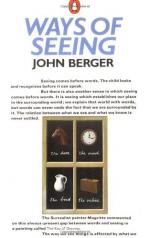|
This section contains 602 words (approx. 2 pages at 400 words per page) |

|
Ways of Seeing Summary & Study Guide Description
Ways of Seeing Summary & Study Guide includes comprehensive information and analysis to help you understand the book. This study guide contains the following sections:
This detailed literature summary also contains Topics for Discussion and a Free Quiz on Ways of Seeing by John Berger.
A child sees before it learns to speak. Seeing also enables an individual to relate to the environment that surrounds him. Words are used to try to explain the environment that surrounds. Words cannot settle the matter because they are static and the surrounding environment changes. There is a constant gap between the words used and the sight seen. Berger claims Magritte's painting "The Key of Dreams" comments on this gap.
The painting is comprised of an apparent four-pane window with black background in each pane. Each quadrant contains an image in black and white with white script words below. A viewer might assume there is some relation between the image and the script. A word in the lower right quadrant does indeed state what the picture is. Underneath the image of a suitcase in that pane is written "the valise", which is another word for suitcase, satchel, grip, and other synonyms. Ironically however, below the image of a horse's head in the upper left quadrant is "the door", under an image of a clock in the next quadrant is "the wind", and the lower left pane contains a picture of a pitcher with "the bird" in script below. No "key" or other images or words suggest "dreams" either. Magritte paints in the Surrealist school, which allows him more freedom of expression than Realism would.
The point is made by the painting and Berger's explanation that there is a gap between images one sees and words used to express their meaning in an environment. Berger's work "Ways of Seeing" is a 166-page book including an eight page list of reproductions. The work has seven untitled but numbered chapters called essays in the authors' "Notes to the reader". There is no table of contents that lists titles, numbers, or topics of the seven sections. The book is uniquely structured, since the first chapter is comprised of words and images, but the second is comprised of images only. The third and fourth chapters alternate similarly, as do the fifth and sixth chapters. The seventh and last chapter is comprised of words and images and followed by an index "List of Works Reproduced" with page numbers on which the reproduction is shown. Most pages of text have at least one image and many pages have several images. Several reproduced works also have detail insets on the same or nearby pages. Except for the front and back covers, all written words, reproduced works, and other images in the book are in black and white, bold or gray shade on glossy paper stock.
The book begins uniquely with its core message on the front cover continued on the back. Seeing establishes our place in a surrounding world and at the same time unsettles it in ways the words used to explain it never resolve. The book blends words and pictures to illustrate an interrelated dynamic environment. The work is composed by five authors whose final message converges on its last page "To be continued by the reader. . ." The book is published in 1972 by them in a venture with the British Broadcasting Corporation and Penguin Books. The writing style is dense, pithy, philosophical, and enlightening. Reproduced images are placed in miniature format with several on each image page. Much of the writing relates directly to the surrounding images on the same or adjacent pages. Although original images are assumed to be in full color, they are reproduced in black and white in the book. Presumably, this style of monochrome presentation is selected to enhance the message and avoid any distraction from full color presentation.
Read more from the Study Guide
|
This section contains 602 words (approx. 2 pages at 400 words per page) |

|



